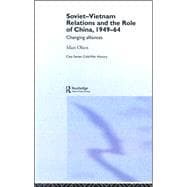
Note: Supplemental materials are not guaranteed with Rental or Used book purchases.
Purchase Benefits
Looking to rent a book? Rent Soviet-Vietnam Relations and the Role of China 1949-64: Changing Alliances [ISBN: 9780415384742] for the semester, quarter, and short term or search our site for other textbooks by Olsen; Mari. Renting a textbook can save you up to 90% from the cost of buying.
| Acknowledgements | ix | ||||
| List of Abbreviations | xi | ||||
| Introduction | xiii | ||||
| 1 Choosing sides: The Democratic Republic of Vietnam and the World, 1945-1949 | 1 | (12) | |||
|
1 | (3) | |||
|
4 | (1) | |||
|
5 | (6) | |||
|
11 | (2) | |||
| 2 Setting the stage: The Soviet Union, China and the First Indochina War, 1949-1953 | 13 | (15) | |||
|
14 | (2) | |||
|
16 | (5) | |||
|
21 | (5) | |||
|
26 | (2) | |||
| 3 The end of the war and the Geneva conference, 1953-1954 | 28 | (20) | |||
|
29 | (7) | |||
|
36 | (2) | |||
|
38 | (6) | |||
|
44 | (4) | |||
| 4 Together for Communism? Sino-Soviet cooperation and the rebuilding of North Vietnam, 1954-1957 | 48 | (24) | |||
|
49 | (4) | |||
|
53 | (2) | |||
|
55 | (4) | |||
|
59 | (3) | |||
|
62 | (4) | |||
|
66 | (4) | |||
|
70 | (2) | |||
| 5 Reunification by revolution? The Soviet and Chinese role in Vietnamese reunification plans, 1957-1961 | 72 | (22) | |||
|
73 | (3) | |||
|
76 | (1) | |||
|
77 | (2) | |||
|
79 | (5) | |||
|
84 | (4) | |||
|
88 | (2) | |||
|
90 | (2) | |||
|
92 | (2) | |||
| 6 The fight over Laos, 1961-1962 | 94 | (19) | |||
|
95 | (2) | |||
|
97 | (3) | |||
|
100 | (5) | |||
|
105 | (3) | |||
|
108 | (3) | |||
|
111 | (2) | |||
| 7 From disinterest to active support, 1962-1965 | 113 | (23) | |||
|
114 | (4) | |||
|
118 | (3) | |||
|
121 | (4) | |||
|
125 | (4) | |||
|
129 | (3) | |||
|
132 | (1) | |||
|
133 | (3) | |||
| Conclusions: Changing alliances | 136 | (15) | |||
| Appendix 1: Politburo and Secretariat of the Lao Dong Central Committee | 151 | (4) | |||
| Appendix 2: Economic assistance and specialists from the Socialist camp to the DRV, 1955-1962 | 155 | (2) | |||
| Appendix 3: Soviet ambassadors to Vietnam, 1954-1965 | 157 | (2) | |||
| Archives in Moscow, Russia | 159 | (2) | |||
| Notes | 161 | (32) | |||
| Bibliography | 193 | (6) | |||
| Index | 199 |
The New copy of this book will include any supplemental materials advertised. Please check the title of the book to determine if it should include any access cards, study guides, lab manuals, CDs, etc.
The Used, Rental and eBook copies of this book are not guaranteed to include any supplemental materials. Typically, only the book itself is included. This is true even if the title states it includes any access cards, study guides, lab manuals, CDs, etc.